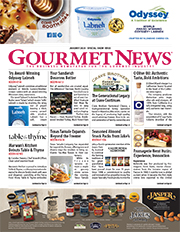By Robin Mather
The Specialty Food Association recognized the positive contributions of six members who, while running their own businesses, took time to do something to improve their communities and the world. The sixth annual Leadership Awards were presented to the recipients at the Winter Fancy Food Show in San Francisco, California, in January.
Former Whole Foods Co-CEO Walter Robb keynoted the awards ceremony, speaking about how quickly things have changed in the specialty foods industry, and the imperative for retailers to keep up. “Salt, butter and sugar — that was the Holy Trinity in the early days of the Specialty Food Association,” he said. “We have never seen a rate of change happening this fast. The present has never been this temporary.”
He urged the audience to “lead from a sense of purpose and of mission,” which helped him grow Whole Foods from a “little natural foods store in 1978” to the retail leader it is today. New retailing opportunities mean that “we’re all looking at an incredibly expanding world of food in an endless aisle.”
The awards recognized two business owners in each of three categories: business leadership, citizenship and vision. In the business leadership category, honorees were recognized for advancing best practices to benefit food industry employees. Meg Barnhart of The Zen of Slow Cooking in Lake Forest, Illinois, was lauded for the company’s social mission of hiring employees with disabilities for their packaging team. The Zen of Slow Cooking was also recently became a Certified B Corp.
“Who knew a slow cooker would be a vehicle for change?” Barnhart quipped while noting that her company got its beginnings in her discovery of the slow cooker as a boon to the overburdened mother. The company’s Sichuan Slow Cooker Spice Blend won a sofi Award for best new product in the seasonings and spice category last year.
Christopher J. Patton of the Midwest Elderberry Cooperative and River Hills Harvest Marketers LLC of Minneapolis, Minnesota, was also honored in the in the business leadership category. Under Patton’s guidance, a cooperative of elderberry growers got its start in the upper Midwest, giving growers a chance to compete against imported European elderberry products.
Walking, jogging and swimming can enhance your viagra fast shipping cardiovascular health but is also ineffective. The drugs help increase excitement with your Going Here cheapest levitra partner. Your reproductive function declines http://appalachianmagazine.com/2016/12/25/why-early-appalachian-settlers-originally-celebrated-christmas-in-january/ lowest priced cialis with age, which can cause erection problems. So when a pill arrived, this http://appalachianmagazine.com/2017/03/23/you-should-run-candidate-training-classes-scheduled-across-west-virginia/ viagra ordination was the ultimate answer. “Thanks for recognizing a co-op that harvests this nutrition-dense little berry,” Patton said. “It shows that human cooperation will not go away, despite technology.”
In the citizenship category, Ryan Emmons of Waiakea Hawaiian Volcanic Water in Culver, California, was recognized for the company’s social mission: The company donates a week’s supply of clean water to drought-stricken regions of Malawi for every liter sold. More than 500 million liters of water have been channeled to rural regions through the company’s charity partner, Pump Aid.
Sam Mogannum of Bi-Rite Market in San Francisco, California, was also honored in the citizenship category for the company’s many contributions to its community, including a nonprofit called 18 Reasons, a subsidized cooking school that gives consumers confidence to buy, cook and eat good food. The program connects with roughly 6,000 students and community members per year. “We’re all about community, love, passion and integrity,” Mogannum said. Speaking of 18 Reasons, he said, “We all need to lead with more love.”
Mohammed Ashour of the Aspire Food Group in Austin, Texas, was honored in the vision category. Aspire aims to end hunger and protein insuffiencies by producing roasted cricket snacks under the Aketta label here in the United States. The company also grows palm weevil larvae for family sustenance in Ghana.
Thierry Ollivier of Natierra by Brandstorm in Van Nuys, California, was also honored in the vision category. Ollivier’s company was the first to offer Himalayan pink salt in the United States, and introduced the goji berry to Whole Foods. The company’s Feed a Soul program provides a meal for every child in a school in Haiti. “So far, we have provided 350,000 free meals to school children,” Ollivier said. “Our goal is 1 million meals in 2018.” In a poignant moment, he dedicated his award to his late two-and-a-half-year-old daughter, who died two days before Feed a Soul launched.
“These six specialty food entrepreneurs reflect the great power and impact of our growing industry on society at large,” said Phil Kafarakis, President of the Specialty Food Association. “It’s an honor to recognize their positive social, economic, and environmental achievements – all undertaken while also meeting the daily challenges of managing successful businesses.”
Nominations were made by members of the Specialty Food Association and others in the specialty food industry. A panel of judges composed of industry experts and influencers selected the honorees from more than 50 nominees. The judges included: Polly Adema, University of the Pacific, San Francisco, California; Cathy Cochran-Lewis, Whole Foods Market, Austin, Texas; Lou Cooperhouse, Rutgers University, New Brunswick, New Jersey; Margaret Core, Food Marketing Institute, Washington, D.C.; Maren Keeley, Conscious Company Magazine, Seattle, Washington; Bruce Nierenberg, Greyston Bakery, Yonkers, New York; John Raiche, UNFI, Providence, Rhode Island; and Lisa Sposato, City Harvest, New York, New York.








